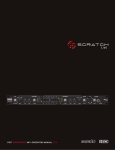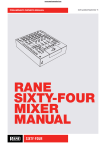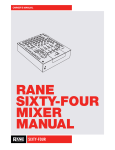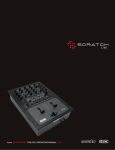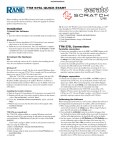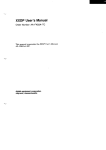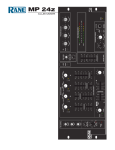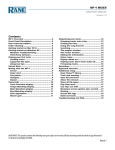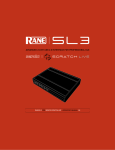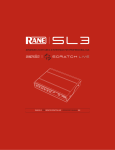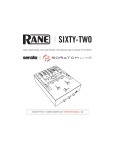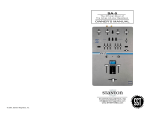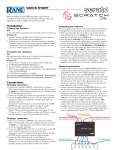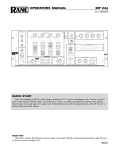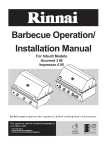Download Rane MP 4 Operator`s manual
Transcript
TTM - OPERATOR’S MANUAL 1.8.1 MP 457SL - OPERATOR’S MANUAL 1.8.2 1 2 MP 4 - OPERATOR’S MANUAL 1.8.2 Important Safety Instructions 1. Read these instructions. 2. Keep these instructions. Introduction 4. Follow all instructions. Beyond the Quick Start guide, please read through this manual to get the most from your MP 4 and the included Scratch LIVE software. Keep this manual in a safe place. If you lose yours, a new copy may be downloaded at www.rane.com/mp4.html. 5. Do not use this apparatus near water. 6. Clean only with a dry cloth. 7. Do not block any ventilation openings. Install in accordance with manufacturer’s instructions. 8. Do not install near any heat sources such as radiators, registers, stoves, or other apparatus (including amplifiers) that produce heat. 9. Do not defeat the safety purpose of the polarized or grounding type plug. A polarized plug has two blades with one wider than the other. A grounding-type plug has two blades and a third grounding prong. The wide blade or third prong is provided for your safety. If the provided plug does not fit into your outlet, consult an electrician for replacement of the obsolete outlet. 10. Protect the power cord and plug from being walked on or pinched particularly at plugs, convenience receptacles, and the point where it exits from the apparatus. 11. Only use attachments & accessories specified by Rane. 12. Use only with the cart, stand, tripod, bracket, or table specified by the manufacturer, or sold with the apparatus. When a cart is used, use caution when moving the cart/apparatus combination to avoid injury from tip-over. 13. Unplug this apparatus during lightning storms or when unused for long periods of time. 14. Refer all servicing to qualified service personnel. Servicing is required when the apparatus has been damaged in any way, such as power supply cord or plug is damaged, liquid has been spilled or objects have fallen into the apparatus, the apparatus has been exposed to rain or moisture, does not operate normally, or has been dropped. 15. The plug on the power cord is the AC mains disconnect device and must remain readily operable. 16. This apparatus shall be connected to a mains socket outlet with a protective earthing connection. 17. When permanently connected, an all-pole mains switch with a contact separation of at least 3 mm in each pole shall be incorporated in the electrical installation of the building. To keep up with the latest tips, and to check for software updates for your MP 4, visit the official Scratch LIVE Forum at scratchlive. net. • Computer with USB 1 port supporting Full Speed Mode (USB 1.1). • Hard drive space for storing music. PC • Windows XP with Service Pack 2 or Vista with Service Pack 1 • Pentium 4 / 1.5 GHz • 1 GB RAM. Mac • OSX 10.3 Copyright Notices • G4 / 1 GHz • 1 GB RAM. © 2008 Rane Corporation. All rights reserved. Scratch LIVE and the Scratch LIVE logo are trademarks of Serato Audio Research. Trademarked in the U.S. and other countries. Licensed exclusively to Rane Corporation. This software is based in part on the work of the Independent JPEG Group, and uses libpng code, copyright © 2000-2002 Glenn Randers-Pehrson. The Scratch LIVE Control Tone, the audio pressed on Scratch LIVE Control Vinyl and Control CDs, is copyright ©2004-2008 Serato Audio Research. The Control Vinyl and Control CDs are licensed for personal use only. The creation of personal backups of the Control CD is allowed, however duplicating Control CDs for commercial benefit is strictly prohibited. For avoidance of doubt the duplication or creation of Control Vinyl for any use is strictly prohibited. Please respect our copyright. ©2004-2008 Serato Audio Research. Windows XP and Vista is either a registered trademark or a trademark of Microsoft Corporation in the United States and/or other countries. Apple, Mac, Macintosh and iTunes are trademarks of Apple Computer, Inc., registered in the US and/or other countries. Scratch LIVE is compatible with Intel-based Mac computers. Check List These items are included with the MP4 in the box: • Scratch LIVE software install disc. • 1 USB cable. • IEC C5 line cord. • Package of 4 rubber feet. • Quick Start Guide. • This manual. Warning To reduce the risk of electrical shock, do not open the unit. No user serviceable parts inside. Refer servicing to qualified service personnel. The symbols shown below are internationally accepted symbols that warn of potential hazards with electrical products. CAUTION RISK OF ELECTRIC SHOCK DO NOT OPEN Equipment but some cause an much heat This symbol indicates that a dangerous voltage constituting a risk of electric shock is present within this unit. 19. This apparatus may be installed in an industry standard equipment rack. Use screws through all mounting holes to provide the best support. This symbol indicates that there are important operating and maintenance instructions in the literature accompanying this unit. MP 4 - OPERATOR’S MANUAL 1.8.2 Minimum System Requirements • Screen resolution 1024 x 768 or higher. 3. Heed all warnings. 18. If rack-mounting, provide adequate ventilation. may be located above or below this apparatus, equipment (like large power amplifiers) may unacceptable amount of hum or may generate too and degrade the performance of this apparatus. WARNING: To reduce the risk of fire or electric shock, do not expose this apparatus to rain or moisture. Apparatus shall not be exposed to dripping or splashing and no objects filled with liquids, such as vases, shall be placed on the apparatus. 3 CONTENTS Important Safety Instructions 3 main screen overview 12 Introduction 3 Virtual Deck 12 Copyright Notices 3 Visual Aids 13 Warning 3 Tempo Matching Display 13 Minimum System Requirements 3 Track Overview Display 13 PC 3 Main Waveform Display 13 Mac 3 Beat Matching Display 13 Master Gain 13 Check List 3 Tap Tempo 14 MP 4 Overview 6 Key Lock 14 Inputs 6 Repeat 14 Outputs 6 Censor 14 Recording 6 Eject 14 Cueing 6 Fader Start 14 Track Gain 14 Mixing With The MP 4 15 Pitch Sliders 15 Temporary Cue 15 Cue Points 16 Front Panel Description Rear Panel Description 8 Scratch LIVE: Getting Started 9 Mac OS X 9 Windows XP 4 7 9 Windows Vista 10 Looping 17 Windows Troubleshooting 10 Auto Looping 17 Third-Party Software 10 The A - Slot 17 Using the Tool Tips 10 MIDI Control 18 Importing and playing music 11 Overview 18 Importing Your Music 11 MIDI Controller Setup 18 Supported File Types 11 Assigning Controls 18 Playing Music 11 A note about MIDI Platters 18 Track Display 11 Assigning MIDI to other Controls 18 PREPARING YOUR FILES 12 BuIlding Overviews 12 How to Build Overviews 12 About Corrupt Files 12 Set Auto-BPM 12 The Offline Player 12 Assigning Ctrl-Click Functionality 18 Presets 18 Native Controller support 18 Technical Information 18 MP 4 - OPERATOR’S MANUAL 1.8.2 Organizing your music 19 Display 24 19 Maximum Screen Updates 24 19 Audio Cache 24 Sorting Your Files 19 Horizontal Waveforms 24 Using the Song Browser 19 Searching 19 USB Dropout Indicator 25 Prepare Window 19 Review Window 20 Editing ID3 Tags 20 Display Album Art 20 Status icons 20 More info on corrupt files 20 Auto-Backup 20 Deleting Crates and Tracks 20 Grouping Tracks into Crates Subcrates Recording 21 Keyboard Shortcuts 22 Additional Setup 23 Playback 23 Track End Warning 23 Playback Keys Use Shift 23 Lock Playing Deck 23 Sort Cues Chronologically 23 Auto Gain 23 Modifying the Auto Gain Level. 23 Hi-Fi Resampler 23 Play From Start 23 Instant Doubles 23 Play From First Cue Point 23 Audio Output 23 Library 23 Read iTunes™ Library 24 Protect Library 24 Center on Selected Song 24 Show All File Types 24 Include Subcrate Tracks 24 Auto Fill Overviews 24 Import AAC Files 24 Rescan ID3 Tags 24 Relocate Lost Files 24 MP 4 - OPERATOR’S MANUAL 1.8.2 Troubleshooting and Frequently 25 Asked Questions Corrupt File Descriptions and Diagnoses 26 Fader Cleaning 27 5 MP 4 Overview Two CD players or Two Turntables or One of Each. 100-240V 50/60 Hz 7 WATTS MP 4 MADE IN U.S.A. RANE CORP. FOR CONTINUED GROUNDING PROTECTION DO NOT REMOVE SCREW HOUSE AUX MIC TO USB RECORD LEVEL USB RIGHT LEFT RIGHT LEFT RIGHT LEFT MIC PHONO GROUND BALANCED OUTPUTS: TIP = (+), RING = (–), SLEEVE = SIGNAL GROUND ACN 001 345 482 L BALANCED INPUT R NO YES LINE PHONO IN 2 IN 1 LINE PHONO The MP 4 combines Rane mixer technology and Serato Scratch LIVE software. The result is a mixer with the flexibility of playing digital music directly from your computer while still supporting traditional analog inputs. This two-bus mixer Zone 1 Amp is able to simultaneously play stereo analog Zone 2 Amp sources, play stereo digital files, and digitally record Mic, Program A, Program B or Main-mix. You can also operate the MP 4 as a stand-alone applications may vary and compatibility is not Outputs analog mixer without a computer, or use it as a guaranteed. Two stereo analog outputs are provided. The high-quality six-channel sound card with Serato The computer sees the MP 4 as three USB HOUSE output is available on both balanced Scratch LIVE software, without analog sources. audio devices (two stereo play and one stereo XLR and balanced ¼” TRS connectors. The The MP 4 is targeted at mobile DJ, night record). ASIO (for PC) and CoreAudio (for Mac) AUX output is available on balanced ¼” TRS club, remix project studio and post production drivers are included. The digital audio format is connectors and has an independent rear panel applications. The Scratch LIVE MP 4 control 24-bit, 3-byte PCM with a 48 kHz sample rate. LEVEL control. Inputs Recording PROGRAM A and B INPUT switches select One USB stereo output is available for recording. • Play / pause control, both forward and reverse between the two LINE and two USB Inputs. LINE Scratch LIVE software allows selecting Mic, • Pitch and bend controls for fine tuning beat 1 and LINE 2 are set for PHONO level or LINE Program A, Program B or Main-mix as the source. matching level using the associated push switch on the The MIC TO USB RECORD switch located on • Fast forward and reverse rear panel. the rear panel determines if the Mic is included • Multiple cue points per track PROGRAM A and B each feature LOW and in the USB Main-mix record output. The ability • Censor (reverse sections without losing play HIGH tone and LEVEL controls. Four-segment to record lets you archive your analog sources, position) program level meters indicate signals from –24 record samples to use in your performance or to • Fader Start; Scrub track with mouse; Autoplay dBu to +12 dBu. Clipping occurs at +22 dBu. record your performance. Crate The balanced MIC input features a full-range screen includes many advanced features that enhance its ability to mix and blend: LEVEL control and is mixed with the Main-mix The MP 4 is not a performance scratch mixer. It does not use control vinyl or CDs and does not have a scratch fader. While the MP 4 may be used as a generic sound card with other software applications, for best performance and support we highly recommend using Scratch LIVE. Performance using other 6 post-crossfader. Cueing Headphone Cueing allows independent selection of the Program A or Program B input, making it possible to Cue any source (digital or analog) with the push of a switch. The PAN PGM / CUE control lets you Pan between the selected Cue input (pre-Crossfader) and the Main-mix (postCrossfader). MP 4 - OPERATOR’S MANUAL 1.8.2 Front Panel Description 6 MIC PROGRAM A LINE 4 2 2 1 6 1 USB 2 4 8 0 10 MIC LEVEL –12 OL INPUT 1 2 +12 –12 LOW +12 HIGH 3 10 4 6 8 PROGRAM B 10 B 0 8 0 2 +12 6 2 0 9 -12 –24 -24 A LEVEL A 10 8 6 4 2 4 0 –12 0 4 5 HOUSE LINE +12 1 6 2 2 1 USB 2 8 0 10 B LEVEL 5 4 4 2 –12 +12 –12 LOW +12 HIGH CUE 8 0 10 INPUT LEVEL 2 7 3 PHONES PAN PGM 6 4 6 0 10 2 A CUE B 8 MP 4 8 MIXER LEVEL POWER 10 11 Feature Description 1 Mic Level Control Adjusts the Level of the MIC Input. The OL (overload) indicator lights when the maximum mic level has been reached, 3 2 Program Input Selectors dB before clipping. If this lights up, either turn the MIC LEVEL down, or stop yelling. Provide selection of LINE 1, LINE 2, USB 1 or USB 2 Inputs for each of the PROGRAM A or PROGRAM B channels. LINE Inputs may each be set for PHONO or LINE level via the rear panel switch (see Rear Panel 6). 3 Program Low And High Tones Adjust the equalization for each of the PROGRAM channels. Pointing these controls straight up at their center detents takes the tone controls out of the signal path. This is not designed to be the only equalizer in the system, this is intended to provide EQ between varying program materials. We recommend an external graphic equalizer for the best system sound, connected between the HOUSE OUTPUTS and the amplifier. 4 Program Level Controls 5 Program Meter 6 Active Crossfader Set the volume of each PROGRAM INPUT, as you would expect! These controls are pre-Crossfader, so both Program Level controls also depend on the Crossfader setting (see 6). This four-segment meter shows signal presence (at -24 dBu), optimum signal level (at around 0 dBu), and a warning to turn down the associated LEVEL control if the +12 dBu indicator lights up. Controls the mix of PROGRAM A and B LEVELS in a logical manner. When the Crossfader is all the way left, only PROGRAM A is heard. When it’s all the way right, only PROGRAM B is heard. When it’s in the middle, both PROGRAM A and B are mixed together equally. This is an Active Crossfader™ which uses a VCA to deliver an extended life with reduced travel noise, but to insure trouble-free operation, see Fader Cleaning on page 4. 7 House Level Meter Adjusts the Output Level of the Main-mix to the HOUSE Outputs. 8 Cue Switches Select Program A or B in any combination to the PHONES. The associated yellow indicator lights when a CUE is activated and pressed in. Depressing a button sends Program signals to the CUE side of the PAN control. For example, when the Crossfader is to the left (playing Program A to the House), listen to CUE B (Program B) on the headphones to audition, match beats or prepare a starting point. 9 Pan Control Changes the relative levels of the Cue and Program mixed together in stereo to the PHONES. Adjust this control anywhere between Program and Cue: PGM follows the Main-mix (House) Output. CUE is determined by the CUE switches and only goes to the headphones. 10 Phones Level And Headphone Jack 11 Power Indicator As you guessed, plug your headphones in here and adjust the overall volume with the LEVEL control. CUE 8 and PAN 9 select the source. MP 4 - OPERATOR’S MANUAL 1.8.2 Illuminates to let you know the MP 4 is plugged in and ready to go. 7 Rear Panel Description 3 COMMERCIAL AUDIO EQUIPMENT 24TJ 100-240V 50/60 Hz 7 WATTS MP 4 MADE IN U.S.A. RANE CORP. 4 HOUSE AUX FOR CONTINUED GROUNDING PROTECTION DO NOT REMOVE SCREW MIC TO USB RECORD 1 RIGHT LEFT RIGHT LEFT RIGHT NO YES LEFT 2 L BALANCED INPUT R LEVEL USB MIC PHONO GROUND BALANCED OUTPUTS: TIP = (+), RING = (–), SLEEVE = SIGNAL GROUND ACN 001 345 482 R 5 LINE PHONO IN 2 IN 1 6 LINE PHONO 7 Feature Description 1 Universal Voltage Input Via a miniature IEC 60320 C6 appliance inlet. This mates with an IEC 60320 C5 line cord (USA domestic). Do not lift the 2 USB Connection ground connection! Attach the included USB cable from here to the computer. The blue LED illuminates when the cable is connected and receiving power. USB delivers two stereo inputs from the computer to the mixer (USB 1 and USB 2), and one stereo record signal from the mixer to the computer. 3 House Output The front panel HOUSE LEVEL control affects the volume at this Output. Connect either the XLR or ¼” TRS (tip-ringsleeve) jacks to a balanced equalizer or amplifier. Both Output types may be used simultaneously if needed. Though not recommended, unbalanced ¼” TS (tip-sleeve) cables may be used for short runs (under 3 meters [10 feet]) to an amplifier with unbalanced inputs. See the RaneNote “Sound System Interconnection” for wiring recommendations. 4 AUX Output This delivers the same signal as the HOUSE Output, but has its own rear panel LEVEL control. This Output is not affected by the front panel HOUSE LEVEL control. These balanced ¼” TRS (tip-ring-sleeve) Outputs connect to a balanced equalizer or amplifier (for a possible second listening zone) and follow the same interconnection rules as above. 5 Mic to USB Record Switch 6 Inputs 1 & 2 In the YES position the Mic signal along with the Program mix is routed to the USB record output. In the NO position only the Program mix is sent to the USB record output. These stereo Inputs are each switchable from a PHONO (RIAA) stage for magnetic cartridges (switch in) to a LINE level Input suitable for any line level device such as a CD player (switch out). Each of these may be assigned to PROGRAM A or B using the front panel INPUT selectors. The PHONO GROUND screw connects those extra wires coming out of the turntables. 7 Mic Input Jack Accepts either a ¼” balanced (TRS) or unbalanced (TS) microphone plug, controlled by the front panel MIC LEVEL control. 8 MP 4 - OPERATOR’S MANUAL 1.8.2 Scratch LIVE: Getting Started On the input tab, you will see four MP 4 devices are free. To install the software, double-click listed. on the installer icon from the CD-ROM, or the installer you just downloaded from scratchlive. They are, in order: net. Follow the on-screen instructions. 5. Click “Next” to continue the install, or choose custom if you wish to change the install directory or choose not to install the ASIO driver. Mac OS X Before you install the Scratch LIVE software, 1. The Main-mix output check for free software updates at scratchlive. 2. Program A net. The software version that came with your MP 3. Program B 4 is printed on the installation CD. The Scratch 4. Microphone 6. Windows may complain that the software driver is not digitally signed. Defy Microsoft and LIVE software is updated frequently, all updates are free, and available at scratchlive.net. The MP 4 can be used with third party software, To install the software, double-click on the as well as the Scratch LIVE software included installer icon from the CD-ROM, or the installer with it. On the Mac, you can use the MP 4 with you just downloaded from scratchlive.net. any audio application, though technical support When you connect your MP 4 to your Mac, is limited to Scratch LIVE. choose Continue Anyway. it will appear to the Mac operating system as multiple sound outputs and inputs. Go to the Windows XP audio section of the system preferences panel to 1. Disconnect any unneccessary USB devices select the desired settings. from your PC. 2. Connect the MP 4 to your computer with the supplied USB cable. 3. The Found New Hardware bubbles appear: MP 4 7. Click Finish once installation is complete. USB Composite Device Scratch Live appears in the Start Menu under All MP 4 USB1 Out Programs > Serato > Scratch Live. USB Audio Device MP 4 USB2 Out Windows XP treats each USB port individually. USB Audio Device You might like to install Scratch LIVE on all MP 4 Line In of your USB ports, so you can connect the USB Audio Device hardware to any port. On the output tab, choose MP 4 USB 1 Out MP 4 As soon as you install the device driver, the or MP 4 USB 2 Out, and on the MP 4 select the USB Human Interface Device operating system does not see the MP 4. That same USB 1 or 2 INPUT. Your new hardware is installed and ready to means you can either [A] not install anything, use. and windows will see the MP 4, or [B] install 4. Before you install the Scratch LIVE software, Scratch LIVE and the ASIO driver, and then you check for free software updates at scratchlive.net. can use the MP 4 with Scratch LIVE or an ASIO The software version that came with your MP 4 is application only. printed on the installation CD. The Scratch LIVE software is updated frequently, and all updates MP 4 - OPERATOR’S MANUAL 1.8.2 9 Windows Vista Third-Party Software When you plug in your hardware: The MP 4 can be used with third party software, as well as the Scratch LIVE software that comes 1. A Found New Hardware wizard will pop up. with it. When you install Scratch LIVE, an ASIO 2. Choose “Locate and install driver software”. driver will also be installed. You can use the MP 3. After Windows looks for the driver it will say 4 as a sound card for any third party software “Windows couldn’t find driver software for your that supports the ASIO standard. Go to the device”. Choose “Browse my computer for audio interface control panel in the third party driver software”. software, and choose the MP 4 Driver. Launch 4. Browse to the location that you extracted Control Panel to access more settings for the the ScratchLIVE .zip file to. Choose the Drivers MP 4 ASIO driver. folder. You can reduce the USB Buffer Size for lower 5. Click next and Windows will say “Windows latency. can’t verify the publisher of this driver software”. Click “Install this driver software anyway”. 6. When you see the bubble “Your new hardware is installed and ready to use,” proceed to install the Scratch LIVE driver. Windows Troubleshooting If you have a USB PCI card, your computer may have allocated bandwith to other devices, including your mouse, preventing Scratch LIVE from recognising the MP 4. Unplug unneccesary devices and install Scratch LIVE again. You may Using the Tool Tips need to temporarily move your mouse to the built-in USB port. After installation, reconnect USB units as needed. If other USB devices steal bandwidth, you Click on the ? icon to enable tool tips. Tool tips may get a “interface disconnected” message provide a handy way to learn the various features when launching Scratch LIVE, try unplugging of Scratch LIVE. Move the mouse over a section and re-plugging in the MP 4. of the screen to bring up a context-sensitive The ASIO Bit Depth and “Ask host to process tool tip. Holding the mouse over the ? button during callback” settings should not be adjusted with tool tips turned on will show you a list of unless you are having problems. all keyboard shortcuts. Tool tips are available in Uncheck “Ask host to process during callback” several languages. Scratch LIVE will display the if you have audio dropouts. Your application may tool tips in the language that your computer is not support an ASIO bitdepth of 32-bit. If this is set to. If your language is not available, the tool the case, there will be no audio sent to the MP tips will be displayed in English. 4. 10 MP 4 - OPERATOR’S MANUAL 1.8.2 Importing and playing music 2.Once you have located your music, drag playing music the folder or files you want to import onto the Click on the All… icon to show all the tracks purple “All...” icon. This is located to the left of in your library. Use the keyboard shortcut Shift your screen at the top of the crates and playlist - Left Arrow to load the highlighted track on to window. the left deck, and Shift - Right Arrow to load the If you wish to import all of your music, just highlighted track on to the right deck. drag your whole music folder onto this icon. TIP: You can also load tracks to decks using TIP: You can also import by dragging files the mouse. Click and drag a track from the and folders directly from Windows Explorer track list area on to either deck. (PC version) or Finder (Mac version) into the Scratch LIVE library. SuppOrted File Types Track Display When a track is loaded, the track name, artist and length are displayed in the track title bar, Importing Your Music Scratch LIVE supports fixed and variable bit rate The easiest way to load music into your library is and the Virtual Deck shows a solid black line. .MP3, Ogg Vorbis, AAC, .AIFF, and .WAV file by using the import button: If the track has BPM information written in the types. M3U playlists are also supported. tag this will also be displayed. 1.Click on the import button to open the import NOTE: iTunes Music Store DRM files cannot panel. The left side of this window displays See: Set auto-BPM (page 12) be played back by Scratch LIVE. various locations on your computer hard drive (and external drives if you have one). Click on these locations to navigate your computer and find your music. By default, your music will usually be found in either “Music” (Mac) or “My Music” (Windows). MP 4 - OPERATOR’S MANUAL 1.8.2 11 Set Auto-BPM If this option is checked, building overviews will PREPARING YOUR FILES main screen overview If this option is checked while building overviews, Scratch LIVE will calculate the estimated tempos of your files. If Scratch LIVE is confident that the auto-BPM estimate for a file is accurate, it will be written to an ID3 tag* in the file. The auto-BPM function will not be applied if the track already contains BPM information. To rebuild overviews and use auto-BPM or auto BuIlding Overviews Before you play your music in Scratch LIVE, It is important to first prepare your files by building overviews. The overview builder analyses the songs in your library to detect file corruption, saves the waveform overview to an ID3 tag*, and calculates auto-gain and bpm values. gain on those files, drag them onto the build overviews button. If you know your files BPM will fall within a certain range, use the range drop *ID3 tags contain data about your tracks common tag information. To build overviews start Scratch LIVE with the See: editing id3 tags (page 20) main screen, you will notice a button labeled “build overviews”. Click this to automatically build the overviews for all the tracks in your library. TIP: You can drag and drop individual folders, crates or files onto this button to force the building of overviews at any time. About Corrupt Files The Offline Player Virtual Deck Virtual Deck shows everything about the speed and position of a track. As the vinyl rotates, so does the line on the label. The The offline player is available when Scratch LIVE circular progress bar hardware is not connected, and outputs through around the edge is a visual representation of the current default audio device. Load a track to the position within the song, and can be set to the offline player by dragging and dropping onto flash to warn you that the track is nearing its the deck, or pressing shift+left arrow. If the end end. The time and remaining time are displayed of the loaded track is reached, the next track in in minutes and seconds. The turntable speed the current playlist is played automatically. as a percentage pitch shift is shown on the left of the Virtual Deck, and the pitched BPM (BPM If Scratch LIVE detects a corrupt file it with pitch adjustment multiplier added) is shown will tag it with a corrupt file icon: It is very important that you delete and the Virtual Deck shows a solid black line. calculated. Genre, track name and artist are examples of hardware disconnected. On the left side of the and length are displayed in the track title bar, down to avoid double or half value BPMs being and are saved inside the files themselves. How to Build Overviews When a track is loaded, the track name, artist on the right of the virtual Deck. If the track has ANY no BPM information, pitched BPM will not be corrupt files from your library as they can cause shown. Scratch LIVE to crash regardless if you play the If you are playing regular vinyl, notice that the file or not. Virtual Deck behaves strangely as Scratch LIVE attempts to decode the incoming signal. This See: Status icons (page 20) and Corrupt File The offline player is a useful tool for preparing Descriptions and diagnoses (page 30) will not cause any problems, but you may find it crates, auditioning tracks, and setting cue and distracting. You can unload the currently loaded loop points. track using the eject button next to each Virtual Deck. 12 MP 4 - OPERATOR’S MANUAL 1.8.2 TIP: Use the keyboard shortcut shift-alt-arrow auto fill overviews in the setup screen – with this Beat Matching Display to unload a track from the Virtual Deck. setting disabled, the overview will be filled as This view shows the position of beats you play the track. within the track. When beat matching, Visual Aids When the track is playing several waveforms are Main Waveform Display this view helps align the downbeats of the two tracks. The markers are displayed. Each shows a different aspect of the This view provides a close- matched up when the two tracks are track being played. up beat matched. view including Tempo Matching Display The Tempo Matching display area provides a helpful tool for beat matching. Scratch LIVE detects the beats within the track, and places a row of orange peaks (for the track on the left side) above a row of blue peaks (for the track on the right side) in the Tempo Matching display area. When the two tracks are matched to the same tempo, the peaks will line up. Note that the tempo display is aligned with the beginning of the bar, so the peaks keep their relative position as the track plays. This display does not show the relative timing of the beats, only the tempos of the tracks. The peaks will still line up when the of the color track, coding to Track Overview Display This view provides a complete overview of the waveform of the track, and includes a marker to show the current position waveform is colored according to the following is a sound; red representing low to help beat match. In this example, frequency bass sounds, green the track that is playing is on the left representing deck, and the track to be mixed in is mid-frequency sounds and blue representing on the right deck. high-frequency treble sounds. You can also switch to a three- 1. Start the track playing on the right band spectrum view by holding deck. After a few seconds, blue peaks appear in the ctrl key and clicking on the Tempo Matching display. the waveform. Click on the 2. Adjust the pitch of the right turntable until the waveform to ‘scrub’ or make blue peaks sit under the orange peaks in the fine adjustments to your position within the Tempo Matching display. Once they are aligned, track. This applies to int mode only, and may the two tracks have the same tempo. be useful if you wish to set cue points in your 3. Next align the markers in the Beat Matching tracks without your turntables or CD players display. Watch the color of the items passing by connected. The Main Waveform is zoomed in the Main Waveform display. Remember that a around the current position in the track. kick or bass drum will be red in color, and a snare drum will be green or blue. This technique will by no means guarantee perfect mixes, but may help TIP: Use the + and – keys to zoom in and out. to speed up the process of beat matching. In the example below, the red part of the wave Master Gain represents a kick drum, while the purple part The master output of Scratch represents a snare drum. LIVE can be controlled using the master gain control. This adjusts the output within the track. This view is useful for finding transitions within the track. The The demonstration of using the visual aids tracks are playing at the same tempo, but are out of sync. Example: show the frequency of the volume of all tracks played. Kick Drum NOTE: for best results, set the master gain spectrum of the sound – red representing to the 12 o’clock position, and adjust the low frequency bass sounds, green volume of individual tracks using the track representing mid frequency sounds and gain adjustment. blue representing high frequency treble sounds. You can jump to different positions within the track by clicking on the Track Snare Drum Overview display (disabled in abs mode). Grey lines behind the overview show the length of the track – a thin grey line every minute, and a thick grey line every 5 minutes. The overview will be filled when you load the track onto a Virtual Deck. On slower computers, you should disable MP 4 - OPERATOR’S MANUAL 1.8.2 13 Tap Tempo Repeat the left deck, and k for the right deck. The fader For tracks with no BPM information, Use the repeat function to repeat the start point is not saved with the file, and by there song across the entire length of the default this point is set to the start of the track. is a tap tempo button displayed where the BPM usually control record. is, in the song info area. Pressing alt-space bar activates the tempo tapper (press alt-space bar TIP: Short “loop” samples can be turned into a second time to activate the tempo tapper on a continuous track using the repeat function. the right Virtual Deck). Tap the space bar along The loops must be less than 10 seconds long, with the beat. After you’ve tapped the first beat, and cut at the start and end of a bar. you can switch to double time tapping, half time, start of each bar etc. The range is set by Censor the first two taps, after that you can switch to Use the censor button to ‘mask’ parts any steady rhythm you feel comfortable with – of a song, or use as a special effect. quarter notes, half note, whole notes. Esc resets When you press the censor button, the track the BPM, Enter saves the BPM to the track. You starts playing backwards from that point. When can use the mouse if you prefer. Your CD player you release the censor button, the track plays or turntable’s pitch slider doesn’t need to be at forward from the point you would have been, zero, we do the math for you. You can also use had you not pressed the censor button. the tempo tapper when no song is loaded, for finding the BPM of regular records, for example. Key Lock Eject This ejects the track playing or loaded track from the Virtual Deck. When Key Lock is on, the key or pitch of the song stays locked at what it would be if the track was playing at normal speed, regardless of the platter speed of the turntable or CD player. Key Lock has scratch detection, so that it automatically turns off when scratching for a natural scratching sound. Turn Key Lock on or off by pressing the button to the top right of the Virtual Deck. TIP: F5 and F10 will turn Key Lock on and off for the left and right decks respectively. Fader Start Autoplay Click the auto button to enable autoplay. With this setting turned on, when one track finishes playing, the next track starts automatically. Load from a crate to play through the songs in that crate, or from your library to play through your library. Use the next | and previous | buttons to jump to the next track or go to the previous track in the list. Play from start must be checked in the setup screen for autoplay to work correctly. Track Gain Use the track gain adjustment to balance the volume of the tracks in your library. Any adjustment made to the gain of a track is saved with the file, and will be reapplied to the entire track when it is loaded again. The level meter shows the level sent to the hardware Playback may be triggered from the Crossfader interface after both individual track using the fader start feature. To start playback gain and master gain adjustment. using the Crossfader, pause the track at the desired position and press the fader start button. Now each time you move the Crossfader from its end position, the track will start playing from that NOTE: for automatic gain setting of your tracks, see Additional setup. point. Moving the Crossfader from the right end point will start the left deck when fader start is turned on, and moving the crossfader from the left end point will start the right deck when fader start is on. You can set the fader start point using the keyboard shortcut ctrl-i for the left deck, and ctrl-k for the right deck. You can also jump to this point without moving the fader by pressing I for 14 MP 4 - OPERATOR’S MANUAL 1.8.2 Mixing With The MP 4 Pitch Sliders Left Deck Function Scratch LIVE has two pitch sliders Q play / pause reverse A – a large slider for coarse pitch W play / pause forward S adjustment, and a small pitch slider E pitch down D for fine adjustments. Click above R pitch up F or below the handle on the large T bend down G pitch slider to make small pitch Y bend up H adjustments, or hold the shift key Alt-Q load previous track Alt-A and drag the pitch slider to move it Alt-W load next track Alt-S slowly. Drag the center of the small Alt-E rewind Alt-D pitch slider to make fine pitch adjustments, or Alt-R fast forward Alt-F click on either side of the small slider to pitch Ctrl-I set temporary cue point Ctrl-K Right Deck bend. Click on the waveform to ‘scrub’ or make fine Scratch LIVE software has many features allowing you to smoothly mix two tracks together. From left to right, these are: Rewind - The rewind function speeds up the longer you press the button. Bend down - Create a temporary decrease in the playback speed. Use bend down if the two tracks are in time, but this track is slightly ahead of the other track. Play / pause reverse - Press to play, press again to stop playback. You can adjust the braking knob in the setup screen to range from an immediate stop to a slow turntable-style ‘power down’. Play / pause forward – Press to play, press again to stop playback. Uses the same braking as described above. Bend up – Create a temporary increase in the playback speed. Use bend up if the two tracks are in time, but this track is slightly behind the other track. adjustments to your position within the track. Temporary Cue There is a temporary cue point that can be used like the Cue button on many DJ CD players. Press ctrl-I to set this temporary cue point on This may be useful if you wish to set cue points in your tracks, and don’t have your turntables or CD players connected. the left deck, and ctrl-K to set it on the right deck. This temp cue point is shown in the main waveform as a white marker. This cue point is not saved with the track, and by default is set to the beginning of the track. Press I to jump to this temporary cue point on the left deck, and K for the right deck. If you hold down the I or K key while the track is stopped, it will play from the temp cue point. As soon as you release the key, it will jump back to the temp cue point. Note that you can use this shortcut to jump to the beginning of the track if the temporary cue point has not been set. See Cue points. The buttons above the small pitch slider allow you to seed the base playback speed – 1/2 (half speed), 33/45 or the speed of a 45 rpm recording playing at 33 rpm, 1x or normal speed, 45/33 or the speed of a 33 rpm recording playing at 45 rpm, or 2x (double speed). You can also control playback using the computer keyboard shortcuts — turn Caps Lock on to enable. Fast forward – The fast forward function speeds up the longer you hold the button. MP 4 - OPERATOR’S MANUAL 1.8.2 15 Cue Points Each cue point can have a different color. To change the color of a cue point, click on the colored square and choose a new color from the drop down menu. To remove a cue point, use the x button on the right side of the cue point panel. You can set up to five visual cue points within each track. Use the + button to place cue point. Click the arrow to the left of each cue point to jump to it. You can also jump to cue points using keyboard shortcuts – 1 through 5 for the cue points on the left deck, and 6 through 0 for the right deck cue points. Notice that the stripe on the Virtual Deck jumps to the 12 o’clock position and changes color when you set a cue point – you are at the cue point when the stripe is one solid color and at the 12 o’clock position. A cue point can occupy any of the 5 slots. You can drag and drop cue points to change their order in the list. If you wish to have the cue points sorted chronologically, check the sort cues chronologically option in the setup screen. If you load the same track on to both decks, you will be able to add or modify cue points from either deck. When you jump to a cue point in internal mode while paused, the track will play from the cue point for as long as the key or mouse button is pressed, after which the playhead returns to the cue point. TIP: The rate of cue point stuttering is controlled by your operating keyboard repeat rate settings. system Windows users: Keyboard properties are in the Control Panel. Mac users: Keyboard and Mouse are in As the record plays on beyond the position of the cue point, the colored bar will shorten by a fifth for each rotation. Likewise, as you approach the cue point, the color will grow by a fifth each rotation. For example, the picture in the next System Preferences. TIP: Use the keyboard shortcuts ctrl-comma (for left) and ctrl-dot (for right) to place cue points. column shows the record just before the end of the 5th rotation before the cue point. 16 MP 4 - OPERATOR’S MANUAL 1.8.2 Looping click on the locked loop symbol, a red border The A - Slot will appear. This indicates the loop is locked, and A special loop slot ‘A’ exits for auto-looping. The you will not be able to adjust the end points or act of using the auto-loop buttons sets a loop delete the loop until you unlock it, by clicking on in the ‘A’ slot, following the rules above. Turning the number again. a loop off using the auto-loop buttons returns Auto Looping You can save up to 9 loops per track; these loops are saved in the file, and will be present when you reload the track. To make a loop, set the in-point by clicking the in button, and the out-point by clicking the out button. To turn the loop on or off, click the loop button. If you want the playhead to jump to the start of the loop when you enable the loop, hold the control key and press the loop button. To adjust the in-point of the loop, click the in button. You can use the arrow keys: left arrow to move the in-point towards the start of the track, right arrow to move the in-point towards the end of the track. Hold down the shift key while pressing the arrow key to make coarse adjustments. Click the in button again to save the in-point. The same applies to adjusting the out-point. You can also use the control vinyl (or CD) to adjust the in- and out-point. Click the in button, then move the control vinyl. Moving the vinyl will you to the loop slot that you were previously in at the time you started auto- looping. Turning Auto looping allows you the loop off using the ‘loop’ button leaves you to create loops instantly. in the ‘A’ slot. The ‘A’ slot is not saved to disk If the track has a BPM automatically, pressing ‘save’ saves the loop to value simply click the the first empty slot in 1-9. number of bars you wish to loop and Scratch Auto-looping shortcut keys are alt-1 to 5 for LIVE will create the loop for you. The loop is the left deck, and alt-6 to 0 for the right deck. snapped to the beats in the song detected by They correspond to the looping buttons as laid Scratch LIVE so even if when you press the out on screen. ie. if the onscreen buttons display button slightly out of time Scratch LIVE will still 1 2 4 8 16 bar loops, alt-1 triggers 1 bar loop, create a perfect loop for you. and alt-5 triggers a 16 bar loop. Five auto-loop buttons are available on screen at any one time. They range from 1/8 to 32 bars. The user can select the autoloop range with the < and > buttons. Pressing an auto-loop button will create a loop start point from the nearest beat to the playhead (within reason), and set a loop endpoint in the future. Pressing auto-loop 1 while auto-loop 1 is active will deactivate the loop. Pressing a different auto-loop button while looping is active will extend the endpoint of the current loop to the appropriate new auto-loop length. You can also save an auto-loop to the next available slot. When using an auto-loop, a save button is visible where the lock loop button normally is. NOTE: Auto-looping requires the track bpm to be set. adjust the in-point. Once you are happy with the new in-point, click the in button to save, and release the control vinyl. The control vinyl will go back to controlling playback once the record is back up to normal speed. Using the control vinyl to adjust loop end points is optional — to turn this feature off, disable the adjust loops with vinyl option in the setup screen. There are 9 available loop slots per track. If a loop is set in a given slot, the background (behind the loop number) will be green. Press the x button to clear the loop. If you MP 4 - OPERATOR’S MANUAL 1.8.2 17 Assigning Controls Presets To enable MIDI assign mode, click the MIDI Control MIDI button or press ctrl+M. Hovering the mouse pointer over a control will bring up the MIDI assignment box, showing the current assignment status. To assign a MIDI control, click on the control in Scratch LIVE, then move the MIDI control. The MIDI assignment box should update to show it MIDI presets are accessible in the MIDI panel of has mapped the controls to one- another. the setup screen. By default, the current MIDI To un-assign a MIDI control, click on the assignments in Scratch LIVE are automatically control in Scratch LIVE, and press return on your remembered and loaded next time you start the computer keyboard. program. The preset screen allows you to save and recall several different MIDI setups. This Overview NOTE: Once in MIDI assign mode, Scratch is useful if you are using several MIDI devices The MIDI Control feature in Scratch LIVE provides LIVE controls will no longer respond directly or want to quickly switch. MIDI setups without to the mouse. If you need to change a control having to re assign all your controls. the ability to map MIDI controls to Scratch LIVE controls, and thus control the functions of Scratch using the mouse, disable MIDI assign mode. Native Controller support LIVE using MIDI controllers such as keyboards, triggers, sliders, and knobs. Integrating MIDI While in MIDI assign mode, controls which have Scratch LIVE version 1.8.2 currently has native controllers into your Scratch LIVE setup can MIDI inputs assigned show a green box indicator support for the following 3rd party controllers: improve live performance usability, such as around them. hitting pads on a MIDI controller to trigger loops and cue points. A note about MIDI Platters Denon DN-HC4500 Denon DN-HD2500 The Scratch LIVE virtual decks are not user Numark DMC2 MIDI Controller Setup assignable to MIDI control. MIDI devices with Numark iCDX The process of setting up a MIDI controller for platters on them all send different data so user Pioneer CDJ-400 use with Scratch LIVE will vary depending on mapping is not possible. To control the platter the hardware in question. Many devices can use a natively supported controller. connect to a computer using MIDI over USB, These controllers are plug and play, and can automatically control Scratch LIVE with no MIDI and will either be supported directly by your Assigning MIDI to other Controls operating system, or require installation of Controls which aren’t normally visible are drivers and configuration utility software. Follow available for assignment in the lower part of the Technical Information the manufacturers instructions for installation. screen when in MIDI assign mode. These include Scratch LIVE MIDI Control only supports Note Other controllers may solely use a MIDI out library navigation controls and the temporary On/Off, standard 7 bit CC (Control Change), connector to send control messages, and cue points for either deck. 14 bit CC, and RPN/NRPN (14 bit). assigment necessary. will require a separate MIDI interface unit to communicate to software. Generally the MIDI Assigning Ctrl-Click Functionality interface will come with drivers and configuration Some Scratch LIVE controls on the GUI have tools which pass your controllers output onto an additional functionality assigned to ctrl-click. available MIDI channel, which can be used by You can assign ctrl-click functionality to a midi Scratch LIVE. control, alongside the normal functionality. For Once your controller is installed and example, ctrl-click on the internal mode pitch functioning correctly, use the directions for slider returns pitch to zero. To assign this to midi assigning controls below. control, enter midi assign mode, ctrl-click on the slider, and then assign one of the pads to it. When you press the pad, pitch goes to 0. 18 MP 4 - OPERATOR’S MANUAL 1.8.2 TIP: The protect library option in the setup Using the Song Browser screen applies to removing, editing and Organizing your music renaming crates. Check this option to prevent changes to your crates. If you do delete a crate by accident, you can get it back from the recycle bin / trash. Crate files have the extension .crate. Subcrates The song browser allows you to filter your song You can drag and drop crates into other crates list by Genre, BPM, Artist and Album. To turn the to make subcrates. If you drag a crate to the very song browser on or off, click the browse button. left of the crate panel, it will stay in the top level Scratch LIVE can support an unlimited number of tracks – the only limitation is the size of the hard drive of your computer. A number of features are included to help you to keep your music organized and find songs quickly and easily. Grouping Tracks into Crates Scratch LIVE supports several ways of organizing and sorting your file library. iTunes™ users will notice that Scratch LIVE automatically incorporates your existing iTunes library and playlists. Scratch LIVE uses digital “crates” for quick access to your favorite collections. There is no limit to the number of crates you can create, and any given track can be placed in multiple crates. For example, you could organize your files into the following crates, where any one track would be filed in more than one crate: • Hip Hop • UK Hip Hop • French Hip Hop • Inst Hip Hop • Old Hip Hop • Hip Hop LPs To make a new crate, click the + button. To rename a crate, double click the crate name You can change the order of tracks within a crate by dragging them up or down. of the crate structure. If you drag the crate a little Searching to the right, onto the name of another crate, it Scratch LIVE includes a will make the crate you are dragging a sub crate search function to help of the first crate. you find files quickly and easily. Enter text into the Sorting Your Files search box and Scratch The track information display area can be LIVE customized to display the columns listed below: find as you type. To select • Added which fields the search • Album function will look through, • Artist click on the left hand side • Bitrate of the search box. The drop down menu shows • BPM which fields are currently being used. Press esc • Comment or the x button on the right of the search box to • Composer clear the search. will automatically • Filename • Genre TIP: Use the keyboard shortcut ‘ctrl-f’ to jump • Grouping to the search box. This keyboard shortcut will • Label also take you out of any crate or playlist that • Length you might be in and into your main library, • Location so you can find any track in your collection. • Remixer If you then click on a crate or playlist, the • Sampling search query will be cleared. • Size • Track Prepare Window • Video Track The prepare window is a holding area for tracks, • Year much like preparing a set by lifting records part way out of your record bag. You can drag tracks The column button is located at the top (or whole crates) from the main track list into the of the library pane in right hand corner. Click prepare window, or simply drag them onto the on the column button to select which columns prepare button. These tracks will be removed you want to display. For example, clicking on from the prepare window once they have been the album column header will sort your library played. All tracks in the prepare window will be alphabetically by album title. To move a column, discarded when you exit Scratch LIVE. drag the header to the left or right. To resize a column, click on the column boundary and drag it to the left or right. MP 4 - OPERATOR’S MANUAL 1.8.2 19 TIP: Use the keyboard shortcut ctrl-p to add Display Album Art tracks to the prepare window. Auto-Backup Scratch LIVE stores your library database and crates information in a Scratch LIVE folder on TIP: Select the contents of the prepare your hard disk. This folder is created on a drive window, drag them onto the new crate button when files from that drive are added to Scratch (+) to save the selection. LIVE. There is one on your system drive and there will be one on every external drive that you Review Window use with Scratch LIVE. The review window shows the tracks you have MP3 files can contain album art information. To Auto backup creates a copy of the Scratch recently played in the order in which they were display this album art, click the show album art LIVE folder on your system drive once a week on played. Tracks you have played recently are button. There are many third party applications startup. If an external drive containing a Scratch colored green – press the clear button to reset available for adding album art to MP3s. We LIVE folder is detected it will be backed up if the the list of recently played tracks. recommend Apple’s iTunes™. last backup on that drive is older than a week or TIP: Select the contents of the review window Status icons A copy of each Scratch LIVE folder called and drag them onto the new crate button (+) The leftmost column shows the status of each ScratchLIVE backup is created next to the folder to save a history of the tracks you played. track. The image to the left shows five tracks it is backing up. Auto-Backup will only keep ONE with differing statuses. level backup at a time, each time autobackup if no backup exists. Editing ID3 Tags runs it overwrites the previous backup. Much of the information associated with each file • Scratch LIVE has detected some can be edited from within Scratch LIVE. Double corruption in the MP3 file. If possible, click on the attribute within the main library to re-encode the MP3. Deleting Crates and Tracks from Scratch LIVE To delete tracks from your Scratch LIVE library, edit the attribute. Filename, length, size, bit rate and sampling cannot be edited. This information • The track has been imported from the select the track and use the keyboard shortcut is saved in the file itself. Note that the protect iTunes™ library. ctrl-delete. (Make sure you have the protect library option unchecked in the setup menu.) library option in setup must be unchecked to allow edits. See Preparing your files on • The track has been imported from page Manual-15 for details on prebuilding the iTunes library, and Scratch LIVE •Deleting a track when you are in the All...playlist overviews and auto-BPM. has detected some corruption in the MP3 file. removes it from your library and any crates that Solution: If possible, re-encode the MP3. the track may be in. • Deleting a track inside a crate removes it from TIP: Use the keyboard shortcut “ctrl-e” to edit text. Hold down the ctrl key and move • The track cannot be found. Most likely that crate but the file will remain in your All.... with the arrow keys to change to a different the file has been renamed or moved. playlist. • Deleting a track from a subcrate will remove it field while staying in edit mode. When you have more than one file selected, editing tags • Scratch LIVE is trying to import a track from the subcrate and the main crate but not the changes all the files in your selection. from the iTunes library, but cannot find All...playlist. the file. • Crates that are deleted are sent to the recycle bin/trash. TIP: The second column in the library is the label color for that file. Click it to bring up a • Tracks that are read-only have a color palette, and customize the virtual deck locked icon. NOTE: To delete any files from your library and your harddrive (sending them to the recycle for that file. More info on corrupt files bin) use the shortcut ctrl-shift-delete. If you have a corrupt file in your library, hover your mouse over the status icon for information If you are using iTunes playlists, your files cannot on what type of corruption was found. Detailed be deleted this way. You will need to delete them explanations of these messages can be found from within iTunes. on page 34. 20 MP 4 - OPERATOR’S MANUAL 1.8.2 TIPS. • The keyboard shortcut ctrl-n turns recording Recording on and off • You can load a recording without saving it using the short cut keys shift left arrow to deck 1 or shift right arrow to deck 2. • If the Virtual Deck is set to int mode and is unloaded, the input record level is sent to the Virtual Deck’s higher resolution stereo meters. E.g., if you’re recording from input 2, set the right Virtual Deck to int, eject the track if there is one loaded, and the Virtual Scratch LIVE allows you to record one of six Deck’s meters will show the signal coming stereo signals from the MP 4: into input 2. • Mic NOTE: Any recordings over 3 hours are • Program A automatically split into individual files. • Program B • Main Mix 1. Click on the downward arrow (icon) to get the drop menu displaying the six possible record sources. 2. Select the desired source and press the record icon to start recording. 3. The record icon flashes while recording and the display shows the elapsed recording time. 4. Press the record icon again to stop the recording. 5. To save the recording, type in a name for the recording and click the save icon. 6. The recording is automatically placed in a crate named “RECORDED”. If the crate does not already exist, it will be created automatically. 7. To start a new recording without saving, simply click the record button again. Recordings can be loaded onto the decks, renamed, and managed like other files. Recordings are saved in “MyDocuments\MyMusic\ScratchLIVE\Recording” on a PC and “~/ Music/ScratchLIVE/Recording Temp” on a Mac. Recordings are saved as 16-bit, 44.1 kHz stereo AIFF files. MP 4 - OPERATOR’S MANUAL 1.8.2 21 Keyboard Shortcuts These actions can be accessed directly from the computer keyboard. NOTE: Playback, cue and speed controls use Shift or Caps Lock. You can turn this off in the setup screen. 22 Key Action ctrl - L Locate the current track. This will highlight the track you most recently loaded. Pressing ctrl - L again will alternate between the tracks recently loaded on both decks. Reveal - the highlighted song is opened in a file browser. Find - moves the cursor to the search box. Select all. Copy text in edit mode. Edit text. Paste text in edit mode. Cut text in edit mode. Undo last track load. Move focus up / down through the library or crates. Note that if you have a song you will move up or down through highlighted in the song view, and use shift - ctrl the library or crates. When you release the shift or ctrl key, the focus will go back to the . song view so that you can move up and down through songs using Add tracks to the prepare window. Start a new mic recording. Open the track in your default MP3/WAV/OGG/AIF player. Zoom the main waveform display. Alternate focus between crates or songs. Remove track from library, remove track from crate, delete crate (does not delete the file). Remove track from crate and from library ctrl - R ctrl - F ctrl - A ctrl - C ctrl - E ctrl - V ctrl - X ctrl - Z shift ctrl shift ctrl - ctrl - P ctrl - N ctrl - O - or + tab ctrl - del and ctrl - shift backspace alt - del and alt - backspace ctrl - shift - del and ctrl - shift - backspace ctrl - shift / esc Delete the file from your library and send to the recycle bin. (Note to iTunes users: files in your iTunes library cannot be deleted this way). Toggle the input reverse switch. Clear search string if searching, or exit Scratch LIVE. Left Deck Action RIGHT DECK ctrl or shift ctrl - shift ctrl - / shift - alt ctrl - , (comma) 1, 2, 3, 4, 5 F1 F2 F3 F5 Q W E R T Y U I O P [ ctrl - [ alt - Q alt - W alt - 1, 2, 3, 4, 5 alt - E alt - R alt - O alt - L alt - spacebar ctrl -I Load the highlighted song to a deck. Load the track currently on one deck onto the other deck as well Swap the two currently playing tracks from one deck to the other. Unload the track from a deck. Place a cue point. Jump to cue points in track. (rel and int modes) Switch deck to abs mode. Switch deck to rel mode. Switch deck to int mode. Key lock on / off. Play / pause reverse. Play / pause forward. Pitch down. Pitch up. Bend down. (rel and int modes) Bend up. (rel and int modes) Censor. (rel and int modes) Go to temporary cue point. (rel and int modes) Set / adjust loop in-point. Set / adjust loop out-point. Loop on / off. Jump to selected loop. Load previous track. Load next track. Auto-loop on/off Rewind. (rel and int modes) Fast forward. (rel and int modes) Previous loop. Next loop. Activate the tempo tapper. Set temporary cue point. (rel and int modes) ctrl or shift ctrl - shift ctrl - / shift - alt ctrl - , (comma) 6, 7, 8, 9, 0 F6 F7 F8 F10 A S D F G H J K L ; ‘ ctrl - ‘ alt - A alt - S alt - 6, 7, 8, 9, 0 alt - D alt - F alt - P alt - ; alt - spacebar (x2) ctrl - K MP 4 - OPERATOR’S MANUAL 1.8.2 Additional Setup Sort Cues Chronologically TIP: Slightly too quiet is always better than The five cue points can be placed in any order, too loud. If your LED meter is in the red, it is and can be dragged up and down if you wish likely that it is clipping. Not only does clipping to reorder them. If you prefer to lock them to not sound very nice, it can damage your chronological order, turn this option on. equipment. Auto Gain NOTE: Your overviews need to be built by Auto gain enables you to set a uniform volume version 1.7.2 or later for auto gain to work. level for the tracks in your library. When a track is This section covers general preferences and adjustments you can make to improve the performance of Scratch LIVE. From the main screen, tick setup to get to this area. Playback in auto gain mode, the track gain knob appears Hi-Fi Resampler depressed. This significantly reduces digital distortion at very To enable auto gain, go to the setup menu, slow or very fast record speeds, increasing the select the playback tab, and then check the “use CPU load slightly. This option is off by default, auto gain” check box. Provided you have built the old resampler is used when switched off. your overviews, your tracks will now be loaded with the auto gain applied. modifying the Auto Gain Level. Next to the “use auto gain” check box, there is a drop down menu that sets the target gain volume level. Use this to adjust the level of your auto gain. To find the optimum setting, load a track with an average volume level onto one of the virtual decks. Now play the track, and note the volume and LED lights inside the software. Track End Warning The idea is to have the track volume sit just under the clipping point (indicated by the LED Enable track end warning to flash the virtual meter red lining). If the track is too quiet, unload deck as you approach the end of the track. The the track, then go to the setup screen and boost label will start flashing 20 seconds from the end that auto gain db value more. of the record. The track end warning does not Once you’ve made that adjustment, load that apply to any tracks under 1 minute long. same track onto the virtual deck again. Play From Start If this setting is not enabled, freshly loaded tracks will continue to play from the point the last track was at. This option is on by default. Instant Doubles This allows you to quickly match the playhead position of two tracks. With this option set, when you load a track on one virtual deck that is already loaded on the other virtual deck (it must be the same file), the playhead will jump to the position of the track that was loaded first, with the keylock state and looping settings copied. This setting overrides the play from start and play from first cue point options. Play From First Cue Point Notice that the volume knob has turned up and Enable this option to start all tracks from the first Playback Keys Use Shift the volume is louder. cue point. This setting overrides the play from This is checked by default. Unchecking this Keep making those adjustments on that start option. option will enable all of these keys without particular track until its just below the clipping pressing shift or having caps lock on. This point. Once that is set you don’t need to adjust Audio Output applies to all cue points (1...0) and cue controls the target gain level ever again. By default the output of Scratch LIVE is stereo. (QWERTY etc). See Keyboard shortcuts. Because the track you used had an average You can also select mono output. This setting is volume level, most of the other tracks in your saved when you exit Scratch LIVE. Lock Playing Deck Every DJs nightmare used to be lifting the needle of the wrong turntable in the middle of a set. This setting helps to avoid the digital equivalent; loading a new track to the wrong deck. When this option is checked, you can only load a track library will be around the same volume. You may Library still need to turn up the separate track volume when you load a quieter track onto the deck and turn down the louder tracks but once you’ve made those adjustments Scratch LIVE will remember them the next time you load the file. if the target deck is stopped. MP 4 - OPERATOR’S MANUAL 1.8.2 23 Read iTunes™ Library Auto Fill Overviews 3.When this process is complete, your Scratch Existing iTunes users will recognize many Enable this setting to automatically generate the LIVE library will be updated with the new location features from iTunes. Scratch LIVE can read track overview as soon as a track is loaded. If of your files. the iTunes library format, and will automatically this setting is not enabled, the track overview will import the iTunes library and iTunes playlists. be generated as the track plays. Automatically iTunes is available for Mac and PC, for more generating the track overview uses more of the information about iTunes, visit www.apple.com. computer’s CPU power, and should be disabled Click read iTunes library to activate. on slower computers. NOTE: it may take some time to read your Import AAC Files iTunes library if it contains a lot of tracks. If Turn this option off if you do not wish to import you edit the file information of tracks from AAC files into your library. Changing this option your iTunes library, the changes will not will cause your iTunes library to be reloaded if appear in iTunes until after you play the track. you have the ‘read iTunes library’ option turned Scratch LIVE cannot play files that have been on. TIP: You can also drag folders or files from finder (mac) or explorer (windows) onto the relocate lost files button. This is useful if you know the location of files, and can be much faster than scanning all of your drive/s. Display protected by Digital Rights Management systems, such as those sold through the Apple iTunes Music Store. Protect Library Rescan ID3 Tags Click this button to force Scratch LIVE to re-read all file tags. Use this function if you have edited or modified file tags outside of Scratch LIVE. Uncheck this setting to remove files and crates from your library. Enable to lock your library and TIP: Rescanning the tags is a handy way to prevent accidental file or crate deletion while identify all the files that Scratch LIVE can’t using Scratch LIVE. Enabling this setting will also find (for example if the files have been altered lock all file tags and crate names, so that no text or moved). These tracks will show up red can be changed. in the main track list, with an exclamation mark in the status column. You can sort by Center on Selected Song the status column to group all these tracks With this option on, scrolling up and down in your together. Maximum Screen Updates (per second) This feature allows you to throttle back the screen refresh rate. Users with slower computers might like to do this if they are having performance issues. It could also be useful if you want to limit Scratch LIVE’s processor usage, for example if you are running a recording program at the same time. The default setting is 60 Hz, or refreshed 60 times per second. This setting applies to the entire screen (i.e. the Virtual Decks, the Waveforms, the library, and the setup screen). library holds the selected track in the middle of the library panel. Relocate Lost Files This feature is used to find music and folders Show All File Types on your computer that you have either moved Enable this option to show all files when or alterted. importing tracks into Scratch LIVE. If this option If Scratch LIVE cannot locate a file in your is not selected, only files that Scratch LIVE can library, it will be be displayed in pink and display play will be displayed. “file not found” when you try to load it to a deck. Rather than re-importing the files, use this Include Subcrate Tracks You can drag crates into other crates to make subcrates. If you have the “include subcrate tracks” option turned on, any crate will also display the contents of all its subcrates. SEE ORGANIZING YOUR MUSIC. feature to relocate them. To use relocate lost files: 1.Go to the setup menu and select the library tab. At the bottom of this menu is the relocate lost files button. Audio Cache (seconds) Use the slider to set the amount of audio that is loaded into memory. A small audio cache will place less load on your computer, and the tracks will load faster. A large audio cache will give you a bigger view of the waveform when the main waveform view is zoomed out. Horizontal Waveforms Check this option to display the main waveform view horizontally. The waveform will expand to fill available screen space. If you are using a widescreen computer, increase the audio cache size to make the waveform bigger. 2 Clicking this button will search all your drives (internal and external) for files currently marked as not found in your library. 24 MP 4 - OPERATOR’S MANUAL 1.8.2 USB Dropout Indicator The USB dropout indicator on the main screen is a useful trouble shooting tool if you have problems with audio dropouts. drive, and a separate database will be made in Troubleshooting and Frequently Asked Questions Such dropouts are caused by an interruption in this folder. If it is a removable drive, the tracks will only appear in your library when the drive is connected. To keep up with the latest tips, visit the Official Scratch LIVE Forum online at scratchlive.net passing the audio to the Scratch LIVE hardware interface. If such an interruption (or dropout) occurs, a red light will appear briefly, just to the left of the Scratch LIVE logo at the top of the screen. The light will be red for one second, and then orange for four seconds. If you do experience USB drop outs: • Try closing other applications that are running The audio playback is dropping out / clicking / popping at the same time as Scratch LIVE. Scratch LIVE is not getting a clear signal, or your • Try turning off background tasks, for example, computer is not able to process the information wireless networking. quickly enough. •Visit Scratchlive.net for more information and support The first time I play a new track, it takes a while to load If your CPU load is very high, try decreasing the Scratch LIVE has to read the entire file and maximum screen updates (in the setup screen). create a file index the first time it is loaded. This may take a few seconds for longer files. After the first load, it should load instantly. See Build Overviews on page 12. I have a particular MP3 that won’t play / plays badly / takes a long time to load / crashes the program. What should I do? The file may be damaged. Please go to the forum at scratchlive.net and notify the support team that you have a bad file. By reporting damaged or corrupt files, you will help the developers to improve Scratch LIVE’s ability to play damaged MP3 files in the future. I want to backup my library and crates or move them to another machine, so where are they stored? Your database and crates are stored in the folder Home\Music\ScratchLIVE on a Mac, and My Documents\My Music\ScratchLIVE on a PC. Crates have the file extension .crate and are located in your subcrates folder. If your library contains tracks that are stored on a drive other than your boot drive, a folder called _ScratchLIVE_ will be created in the root of that MP 4 - OPERATOR’S MANUAL 1.8.2 25 Corrupt File Descriptions and Diagnoses Corrupt file: This MP3 contains invalid frames. This MP3 contains frames which do not conform strictly to the official MP3 specification. Scratch LIVE can not be certain that this file will play back 100% accurately. Corrupt file: This file contains corrupt frames that This file contains two or more contiguous corrupt frames. Since corrupt frames are replaced with silence, this could may result in audible glitches. result in what might sound like an audio glitch. Corrupt file: This file has been split. You should check The first MPEG audio frame in this file refers to audio that should be present before it but is not. This is usually the the beginning for audio glitches. result of incorrect MP3 editing. Since a corrupt frame is replaced with silence and most songs start with silence, the resulting silence might not be noticeable. All the same, listen to the beginning of the song, just to be sure. Corrupt file: This MP3 contains frames with corrupt Decoding of an MPEG audio frame failed. This means that the frame contained invalid data. As usual with corrupt data. frames, this frame will be played as silence. Corrupt file: This MP3 lost syncronization between Scratch LIVE is reading an old overview of an MP3 that has been edited in a 3rd party editing program. Re-building the frame index and the frames. the overviews for the affected files usually corrects this error. Corrupt file: This MP3 is completely invalid and is not Self explanatory. Possible causes are disk bad sectors, file system corruption, wrong file types, wrong file extensions, playable. etc Corrupt file: This file contains invalid audio data. Scratch LIVE encountered a lot of invalid data while looking for audio in this file. This message alerts you to the fact that the file you're trying to play contains corrupt data. This may, or may not, affect playback. Corrupt file: This MP3 contains no valid frames. No audio could be found in this file, which means it is completely unplayable as far as Scratch LIVE is concerned. Please make sure this really is an audio file. Unsupported file: This MP3 contains multiple layers. While scanning this file, Scratch LIVE found frames belonging to multiple MPEG layers. Scratch LIVE does not support MP3s that contain frames from multiple layers – some frames may be output as silence. Unsupported file : This file is more than 2GB in size. Self explanatory. At the moment, Scratch LIVE does not support files that are 2GB in size (or larger). Unsupported file : This file has data blocks greater This file contains chunks of data that are larger than 2GB. Scratch LIVE does not support files that are more than 2GB than 2GB in size. in size. Corrupt file: This WAV contains no valid chunks. This WAV file contains no recognizable WAV data. It is quite possible that this might not be a WAV file. Unsupported file: This file's data is not in PCM WAV files can contain data in several formats. Scratch LIVE only supports WAV files that contain data in the PCM format. format. Unsupported file: This file has a sampling rate greater Scratch LIVE does not support sampling rates greater than 48 kHz. If you see this message, the simplest approach is than 48kHz. to re-sample the audio at 48 kHz and re-save the file. Unsupported file: This file uses more than 24 bits per Scratch LIVE supports a maximum of 24 bits per sample of audio data. sample Corrupt file: This WAV is incomplete. Scratch LIVE expected more data in the file, but found none. This could be because the file was incorrectly truncated or because the data in the file is corrupt, causing Scratch LIVE to incorrectly estimate the amount of data present in the file. Corrupt file: This file contains corrupt blocks. This file contains blocks of data that report their size to be zero. This message was inserted to identify files that might cause lockups on previous versions of Scratch LIVE. Corrupt file: This song contains no audio data. Scratch LIVE could not find any audio in this file. Please check to make sure this file contains audio in a format that Scratch LIVE supports. Corrupt file: This song contains invalid samples. This file contains samples of audio that are too small to represent accurately and will therefore be truncated to zero. This should not result in any audible audio artifacts, but could cause audio dropouts on earlier versions of Scratch LIVE. 26 MP 4 - OPERATOR’S MANUAL 1.8.2 Cleaning Instructions Fader Cleaning A. Fader assembly replacement (part #11646) 1. Unplug the MP 4. 2. Remove the bottom cover. 3. Remove the fader screws from the front panel. 4. Draw fader assembly out through the bottom. 5. Remove ribbon cable from old fader. 6. Attach ribbon cable to new fader. 7. Screw onto front panel 8. Replace bottom cover. B. Fader cleaning 1. Hold the fader assembly away from the mixer. 2. Position the fader at mid-travel. With heavy use in harsh environments, the fader 3. Spray cleaner/lubricant into both ends of the fader in sufficient amounts to flush debris. may need lubrication. This treatment extends 4. Move the fader over its full travel back and forth a few times. longevity and can make a used fader as good as 5. Shake excess fluid from the fader assembly. new. The fader assembly must be removed from 6. Wipe off excess fluid. the MP 4 for proper cleaning. We recommend any of the following cleaning solutions: • Caig DeoxIT FaderLube F100 spray lubricant • Caig DeoxIT FaderLube F5 spray cleaner • CRC 2-26 (www.crcindustries.com) Order CaiLube MCL® from: CAIG Laboratories, Inc. 12200 Thatcher Ct. Poway, CA 92064 Phone: 858-486-8388 Fax: 858-486-8398 Web: www.caig.com MP 4 - OPERATOR’S MANUAL 1.8.2 27



























